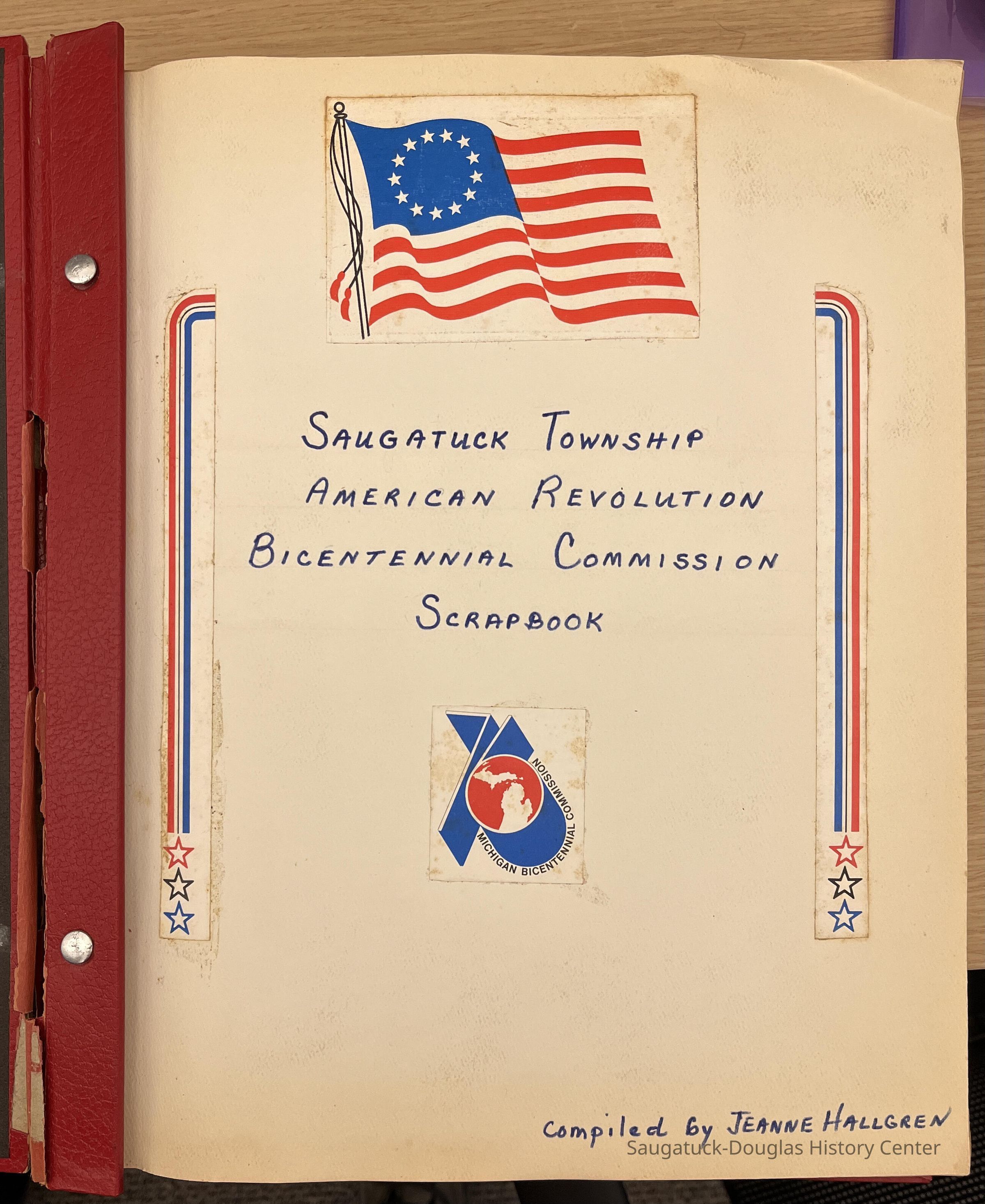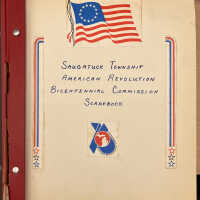Bicentennial Commission scrapbook

2014.02.01
Festivals, events, parades, celebrations
2014.02
Saugatuck-Douglas District Library
Donation
Bicentennial Commission committee1976 BicentennialWicks, (Frank) Memorial ParkBand Shell in Wicks Parkamerican revolutionSaugatuck Township
Hallgren, Jeanne (Mileham) 1932-2020
1976
096 B US Bicentennial 1976 2
Wrobel, Ben
Sheridan, James E. 1909-1996
Hallgren, Jeanne (Mileham) 1932-2020
Erlandson, Sallie (Klug) 1936-2018
Steinberg, Nat 1893-1976
Bandstand, Wicks Park 1976-
Celebrating the Bicentennial of the U. S. The hoopla for the Bicentennial of the Signing of the Declaration of Independence started more than a year before the actual event. A local Bicentennial Committee was appointed and members from each village and the township and several organizations became members. I'm not sure how I came to be on it, but for some reason, I missed the first few meetings. By the time I got to the meetings, under the chairmanship of Ben Wroebel, they had decided that the major Bicentennial project would be a bandstand in the riverside park on Water Street in Saugatuck. The park had been purchased more than 20 years earlier with the generous assistance of Frank Wicks, former owner of the Maplewood Hotel, and village president and council member. It had been leased to help pay off its indebtedness and now the lease was expiring and the city wanted to begin to make it into a real public park dedicated to Mr. Wicks, partly to avoid having the riverfront space turned into a place where boats could be docked, thus limiting public access to the water. Local artist Nat Steinberg, a former editorial artist for Chicago's America had designed an early American octagonal bandstand and the project was on track. We applied for Bicentennial funds from the local municipalities and they responded. We then applied for a Bicentennial Grant for the band stand. I'm not sure how it happened, but at the last minute the grant application was given to me to fill out. It was long and detailed and gave me a chance to list all of the other funds that had been offered by various organizations. I remember only one question. "Who would benefit from this project?" And I could not resist answering something like, "All who want to watch boats float down the river or stroll by the waterfront and feed the ducks." When the announcement came down, Saugatuck-Douglas had received one of the biggest grants bestowed by the Michigan Bicentennial Committee. They were especially taken with the cooperation between our municipalities. Another bicentennial project, which I gather was fairly common especially in towns the size of ours, was to give the fire hydrants a new coat of paint with designs honoring the occasion. The high school classes did the major part of the painting I believe and the town was full of hydrants that looked like little Indians, or Revolutionary soldiers, with a few star spangled ones thrown in for good measure. The grade school also painted one of the school's main hallways with a mammoth bicentennial mural. The larger bicentennial committee was divided into groups with more narrowly defined tasks and I ended up on the education committee, with Debbie Hoffman, and Kathy Herrick and Marty McIntyre from the elementary school, and Marcia Hosley from the high school. We decided to present a good old-fashioned county fair-style competition in handicrafts, cooking, art and music, with a special division for local historical projects. To drum up enthusiasm I was to go around to the schools and present four shows of the various items that might be entered. I did the two elementary school shows and dressed up two of the students in Indian costume. I also presented basic examples (most of them borrowed from my own children) of items that might make good entries. They seemed to take to it quite eagerly. The shows at the high school were a little more complicated. I had brought 20 or so examples of things that might be entered in the county fair competition and each was left backstage with a number on it. When I got to that point in the narrative I would call out a number and Peggy Sanford, who was behind the curtain would send the student out with that numbered item. There were some craft items, a patchwork dress, a bottle of pickles, a loaf of bread, and a big chocolate cake with one slice out of it. It was in the script that I would ask the student, "Who ate a piece of the cake?" and he was supposed to respond, "Must have been the judge." I noticed when the junior high student brought the cake out that the missing piece seemed larger than before, and suspected that students backstage had been doing some nibbling. When the high school students came in I asked principal John Kuenzli who he thought might be good to help with the production, and he suggested Doug Forrester among others. As the luck of the draw would have it, big hulking Doug way the one in line when it became time for the patchwork dress. Fortunately the dress had plenty of elastic, but his appearance in it brought down the house. There were more surprises in store. The number of pickles in the jar had diminished, the bread was a mere crust, and when the chocolate cake arrived, it seems to me that this item also fell to Doug, it was reduced to a mere triangle on the plate. When I asked "Who ate a piece of the cake?" Doug did an exaggerated double take and responded in his deep bass voice, "Must have been the judge." He then strode off the stage polishing off the crumbs as he walked. The Bicentennial pageant was my main part of the events. I wrote up a series of true, but sort of funny, vignettes of Saugatuck-Douglas history and put out a call at the school for students willing to help with it. My son, Eric, was on a Scout Indian dance team and I also contracted with them to present their Indian dances as part of the show. The day of the first rehearsal through announcements and Eric's active recruiting we had managed to secure a small cast including Eric, Alan Gillis (son of the local scoutmaster), Darrin Higgins, Jackie Carey and Mary Beth Kimball and maybe a few others. May Francis Heath had written a syrupy song about Saugatuck for the Saugatuck Centennial in 1930 and I got the music and tried to teach it to the grade school chorus, with the promise to their music teacher that they could sing other folk songs as well. They were also handy whenever we needed more people on stage. The first scene was of the Indians roasting a white dog (a stuffed animal from the toy chest) while the Butler's land at the mouth of the Kalamazoo carrying the china soup tureen they are said to have brought with them. The Indians seem puzzled by the soup tureen. There was a scene of the founding of Douglas where Mr. butcher plats a village named Douglas, and Mr. Wade creates a village called Dudleyville and the people faced each other over Center Street (the people were the chorus which did a wonderful job with little rehearsal.) In rehearsal Darrin Higgins had shown a remarkable talent for falling over and not breaking his fall until just before he hit the floor. So we worked it into a scene with the early Dutch settlers learning to chop down trees from the Indians. The Indian chopped all around the tree until it was standing on a point, and then pushed it the way he wanted it to go. The Indian (Eric) pushed the tree and it obligingly toppled forward {the only way Darrin could fall}. When the Dutch settler tried it the tree began to careen around in circles until the chopper, his companions, and eventually the rest of the trees in the forest (the kids from the chorus again) ran off the stage in terror. Then there was a scene in the Big Pavilion to demonstrate how old Deac Weed would make the dance floor more profitable by shortening the length of time the orchestra would play for each dance. I think that here the chorus played the part of the orchestra. There were other scenes and it was campy enough to be fun. Since the only overhead we had was the Indian dance troop which tried to get $20 a performance we charged only a dime admission. After the show I just dumped all the dimes in a paper bag and handed it to them. The county fair exhibition drew a fair number of entries, even in the adult divisions, and we filled the high school gym May, 6th, 7th and 8th. Members of the committee and a couple of extras, I remember Marty Carey who was then running an art gallery and maybe a few others, did the judging handing out ribbons with a lavish hand, and creating new categories when it looked like somebody was going to miss out. Best of show went to the Erlandson family who had created a diorama of old Singapore from an old plum crate. On Saturday, May 8th we held a field day at the high school stadium with every kind of field event we could think of including running races and wheelbarrow races, with and without real wheelbarrows. Also a pie eating contest at which no hands were allowed. Pies were furnished by the local pie factory as usual, mostly blueberry so the mess could be seen way up in the stands. I remember being in the adult women's arm wrestling finals, but losing out to Fran Manifold. The bandstand was still not done on the 4th of July but we dedicated it anyway with a speech by Ed Hutchinson of Fennville, a longtime U. S. Representative. There was also a presentation of all of the Miss Saugatuck-Douglas, and Mrs. Saugatucks we could find. The most exciting event of the real birthday was the firing of the old cannon in the Village Square. From historical notes it seems that the cannon was fired at all big celebrations like the Battle of Santiago, the end of World War I, the end of World War II, etc., and had been fired at the. Centennial of the nation in 1876. Salt Bryan of the Saugatuck Village Department of Public Works who had previously had some experience with muzzle loading guns, was put in charge. He cleaned out the old cannon and experimented with the amount of powder. Someone on the national level had decided that the official birthday would be at 2 p.m. At that magic hour all of the church bells and any other kind of bells that anyone could lay their hands on around town, began to peal and Salt approached the little cannon and stuffed in a charge of powder holding it in place with paper wadding. He lit it though the hole at the rear and the cannon went off with a big bang blowing shredded paper out the muzzle and lifting itself, wheels and all, eight inches in the air. He filled it with powder for another shot, to celebrate the second century he said, and this time let his young son Frankie light the powder. This time it jumped even higher. Then the cannon was cleaned out to wait for the Tricentennial. A fireworks display, designed to celebrate two hundred years was held that night. -- by Kit Lane https://sdhistoricalsociety.org/publications/NLHist/NLHist/P109-110.php
01/13/2014
11/12/2022


